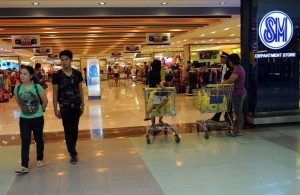Stronger economy in Q2 seen

The Philippine domestic economy likely picked up pace in the second quarter ranging between 5.9 percent and 6.3 percent year on year on the back of robust consumer spending, economists from the country’s three largest banks said. AFP FILE PHOTO
MANILA, Philippines–The Philippine domestic economy likely picked up pace in the second quarter ranging between 5.9 percent and 6.3 percent year on year on the back of robust consumer spending, economists from the country’s three largest banks said.
The forecasts are close to the 6.1 percent gross domestic product (GDP) growth median forecast based on a survey by Bloomberg, where forecasts range from a low of 5.5 percent to a high of 6.8 percent.
In the first quarter, GDP grew by 5.6 percent (revised as of Wednesday) year on year, underperforming the consensus forecast of 6.4 percent. The second-quarter GDP results will be released Thursday.
Emilio Neri Jr., economist at the Bank of the Philippine Islands, said in a text message Wednesday that he was expecting a tempered growth of 5.9 percent as growth would likely be capped by the slowdown in financial services and the transportation sector. The slowdown in the transportation sector, he said, would in turn be due to the congestion in the Port of Manila.
A sharp slowdown in shipment of capital goods was attributed by economic managers to the truck ban implemented by the city government of Manila.
Metropolitan Bank and Trust Co., in a research note issued by analyst Pauline Revillas, said second-quarter growth would likely come in at 5.9 percent, underpinned by solid consumption spending, improvement in external trade and acceleration in the manufacturing sector.
For his part, Banco de Oro Unibank chief strategist Jonathan Ravelas said he was expecting a growth of at least 6.3 percent.
“Some indicators support recovery, such as consumer confidence remaining high, supported by a weaker peso-US dollar [exchange rate] in the second quarter roughly averaging P44:$1,” Ravelas said in a text message. He added that auto sales had remained high and unemployment rate “sidelined.”
The ratio of jobless people in the country eased to 7 percent as of April 2014 compared to 7.6 percent in the same period last year. It was also lower than the 7.5 percent ratio in the previous survey as of January 2014.
